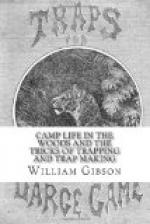[Illustration]
THE COOP TRAP.
This is another excellent device for the capture of birds and large feathered game, and is used to a considerable extent by trappers throughout the country. Like the brick trap, it secures its victims without harm and furnishes the additional advantage of good ventilation for the encaged unfortunate. Any ordinary coop may be used in the construction of this trap, although the homely one we illustrate is most commonly employed on account of its simplicity and easy manufacture. It also does away with the troublesome necessity of carrying a coop to the trapping ground, as it can be made in a very few minutes with common rough hewn twigs by the clever use of the jack knife. The only remaining requisites consist of a few yards of very stout Indian twine, several small squares of brown pasteboard, a dozen tacks and a number of pieces of board five inches square, each one having a hole through its centre, as our engraving (b) indicates. Having these, the young trapper starts out with material sufficient for several coops, and if he is smart [Page 68] will find no difficulty in making and setting a dozen traps in a forenoon.
[Illustration]
In constructing the coop, the first thing to be done is to cut four stout twigs about an inch in thickness and fifteen inches in length and tie them together at the corners, letting the knot come on the inside as our illustration (a) explains and leaving a loose length of about two feet of string from each corner. This forms the base of the coop. Next collect from a number of twigs of about the same thickness, and from them select two more corresponding in length to the bottom pieces. Having placed the base of the coop on the ground, and collected the strings inside proceed to lay the two selected sticks across the ends of the [Page 69] uppermost two of the square, and directly above the lower two. Another pair of twigs exactly similar in size should then be cut and laid across the ends of the last two, and directly above the second set of the bottom portion, thus forming two squares of equal size, one directly over the other. The next pair of sticks should be a trifle shorter than the previous ones and should be placed a little inside the square. Let the next two be of the same size as the last and also rest a little inside of those beneath them, thus forming the commencement of the conical shape which our engraving presents. By thus continuing alternate layers of the two sticks cob-house fashion, each layer being closer than the one previous, the pyramid will be easily and quickly formed. After ten or a dozen sets have been laid in place, the arm should be introduced into the opening at the top, and the four cords drawn out, letting each one lay along its inside corner of the pyramid. Taking the strings loosely in the left hand and having the twigs in readiness, proceed




